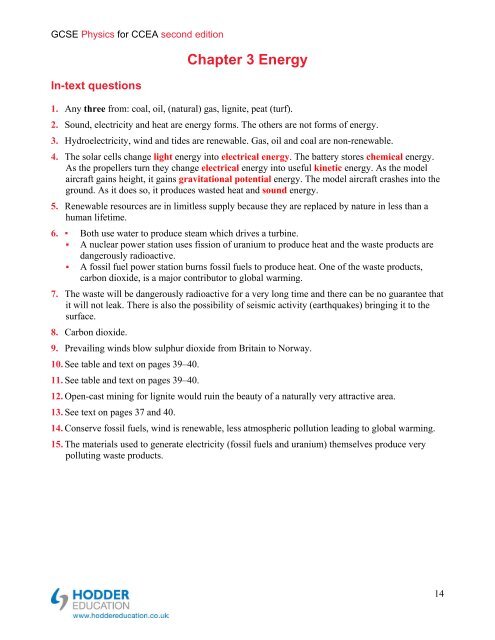Answers to questions in the Student Book - Hodder Plus Home
Answers to questions in the Student Book - Hodder Plus Home
Answers to questions in the Student Book - Hodder Plus Home
You also want an ePaper? Increase the reach of your titles
YUMPU automatically turns print PDFs into web optimized ePapers that Google loves.
GCSE Physics for CCEA second editionIn-text <strong>questions</strong>Chapter 3 Energy1. Any three from: coal, oil, (natural) gas, lignite, peat (turf).2. Sound, electricity and heat are energy forms. The o<strong>the</strong>rs are not forms of energy.3. Hydroelectricity, w<strong>in</strong>d and tides are renewable. Gas, oil and coal are non-renewable.4. The solar cells change light energy <strong>in</strong><strong>to</strong> electrical energy. The battery s<strong>to</strong>res chemical energy.As <strong>the</strong> propellers turn <strong>the</strong>y change electrical energy <strong>in</strong><strong>to</strong> useful k<strong>in</strong>etic energy. As <strong>the</strong> modelaircraft ga<strong>in</strong>s height, it ga<strong>in</strong>s gravitational potential energy. The model aircraft crashes <strong>in</strong><strong>to</strong> <strong>the</strong>ground. As it does so, it produces wasted heat and sound energy.5. Renewable resources are <strong>in</strong> limitless supply because <strong>the</strong>y are replaced by nature <strong>in</strong> less than ahuman lifetime.6. ▪ Both use water <strong>to</strong> produce steam which drives a turb<strong>in</strong>e.• A nuclear power station uses fission of uranium <strong>to</strong> produce heat and <strong>the</strong> waste products aredangerously radioactive.• A fossil fuel power station burns fossil fuels <strong>to</strong> produce heat. One of <strong>the</strong> waste products,carbon dioxide, is a major contribu<strong>to</strong>r <strong>to</strong> global warm<strong>in</strong>g.7. The waste will be dangerously radioactive for a very long time and <strong>the</strong>re can be no guarantee thatit will not leak. There is also <strong>the</strong> possibility of seismic activity (earthquakes) br<strong>in</strong>g<strong>in</strong>g it <strong>to</strong> <strong>the</strong>surface.8. Carbon dioxide.9. Prevail<strong>in</strong>g w<strong>in</strong>ds blow sulphur dioxide from Brita<strong>in</strong> <strong>to</strong> Norway.10. See table and text on pages 39–40.11. See table and text on pages 39–40.12. Open-cast m<strong>in</strong><strong>in</strong>g for lignite would ru<strong>in</strong> <strong>the</strong> beauty of a naturally very attractive area.13. See text on pages 37 and 40.14. Conserve fossil fuels, w<strong>in</strong>d is renewable, less atmospheric pollution lead<strong>in</strong>g <strong>to</strong> global warm<strong>in</strong>g.15. The materials used <strong>to</strong> generate electricity (fossil fuels and uranium) <strong>the</strong>mselves produce verypollut<strong>in</strong>g waste products.14
















